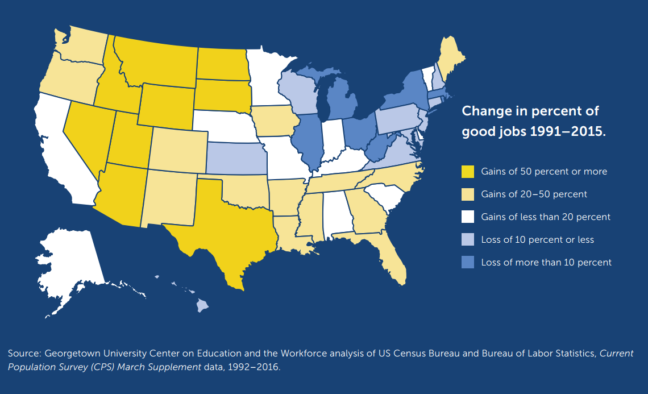Meet the New Good Jobs

Good jobs aren’t gone, but they are changing. As a new report from Georgetown’s Center on Education and Workforce highlights, 30 million Americans have a well-paying job without a Bachelor’s degree. But fewer of those jobs are in “blue collar” industries than ever before. The new frontier for jobs that pay without a BA is in the skilled-services sectors, like healthcare and financial services. These data illuminate critical insights for communities as they work to align their K-12, postsecondary and workforce sectors. We must use this information to rethink our approach to providing meaningful career pathways for all students.
While good jobs that pay without a BA have grown over the last two decades, these opportunities have shifted toward associate’s degree holders and away from workers with a high school diploma or less. In fact, 99 percent of all jobs added after the Great Recession went to workers with some level of postsecondary education and training, leaving behind those with a high school diploma or less. The economy has changed – and our education systems haven’t kept up. Preparing students for good jobs doesn’t have to mean a Bachelor’s degree – but it does mean preparing them for postsecondary education beyond high school, including apprenticeships, industry recognized credentials, and associate’s degrees.
As we consider the economic and workforce development implications of this report, it’s important to remember how these changes must inform our education system:
- Strengthen career readiness, beginning in K-12: In response to these rapid shifts in our economy, states that advance their current systems of career preparation in high school can be ahead of the curve. This includes deepening employer engagement, raising the bar on quality pathways and making career readiness matter in state accountability systems. Through the generous support of J.P. Morgan Chase, 10 states received grants as part of the New Skills for Youth initiative to implement these strategies and serve as leading examples for their peers. Building high-quality options in K-12 will help better prepare students to positively engage in postsecondary education on their path to obtaining a good job.
- Alignment with labor market needs matters: Out with the old, and in with the new. Preparing students for success means focusing on jobs that are in demand today and projecting demand into the future – so we won’t get fooled again. States and communities can make better use of labor market data and projections to scale and phase out programs based on actual hiring trends. Economic reports, such as the one reflecting on the availability of “good jobs,” can serve as an incredibly useful foundation for organizing conversations between K-12 and postsecondary educators, administrators, policymakers and industry. Tight alignment between education and opportunities in the labor market is a precondition for young people to have meaningful routes to career and economic success.
- Increase Postsecondary Attainment: Yes, good jobs that pay without a BA are out there. But don’t mistake “without a BA” for “without postsecondary education.” Almost all states are setting postsecondary credential attainment goals, for the explicit reason of meeting the workforce needs of the state. In setting these goals, states are rightly becoming more sophisticated about the various types of credentials that can lead to long-term economic success. In Oregon, for instance, the state’s goal seeks 40 percent of working adults with associate’s degree or certificate in a skilled occupation. Economic success starts with postsecondary success—and that means certificates, 2-year, and 4-year degrees.
Even as the economy has changed, college has changed, and career opportunities have changed – good jobs remain a critical, foundational element of the way Americans define a good life. The education and workforce sectors must adapt to offer more sub-baccalaureate programs that are attuned to the new needs of the workforce. Through better information and deeper alignment, communities can better prepare all learners for success in the good jobs of today and tomorrow.



